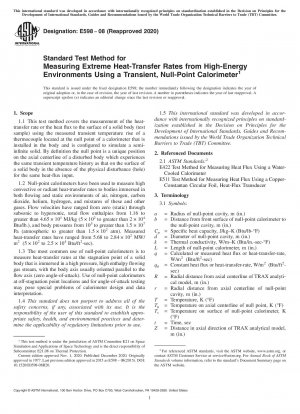ASTM E598-08(2020)
Standard Test Method for Measuring Extreme Heat-Transfer Rates from High-Energy Environments Using a Transient, Null-Point Calorimeter
- Standard No.
- ASTM E598-08(2020)
- Release Date
- 2020
- Published By
- American Society for Testing and Materials (ASTM)
- Latest
- ASTM E598-08(2020)
- Scope
- 1.1 This test method covers the measurement of the heattransfer rate or the heat flux to the surface of a solid body (test sample) using the measured transient temperature rise of a thermocouple located at the null point of a calorimeter that is installed in the body and is configured to simulate a semiinfinite solid. By definition the null point is a unique position on the axial centerline of a disturbed body which experiences the same transient temperature history as that on the surface of a solid body in the absence of the physical disturbance (hole) for the same heat-flux input. 1.2 Null-point calorimeters have been used to measure high convective or radiant heat-transfer rates to bodies immersed in both flowing and static environments of air, nitrogen, carbon dioxide, helium, hydrogen, and mixtures of these and other gases. Flow velocities have ranged from zero (static) through subsonic to hypersonic, total flow enthalpies from 1.16 to greater than 4.65 × 101 MJ/kg (5 × 102 to greater than 2 × 104 Btu/lb.), and body pressures from 105 to greater than 1.5 × 107 Pa (atmospheric to greater than 1.5 × 102 atm). Measured heat-transfer rates have ranged from 5.68 to 2.84 × 102 MW/ m2 (5 × 102 to 2.5 × 104 Btu/ft2 -sec). 1.3 The most common use of null-point calorimeters is to measure heat-transfer rates at the stagnation point of a solid body that is immersed in a high pressure, high enthalpy flowing gas stream, with the body axis usually oriented parallel to the flow axis (zero angle-of-attack). Use of null-point calorimeters at off-stagnation point locations and for angle-of-attack testing may pose special problems of calorimeter design and data interpretation. 1.4 This standard does not purport to address all of the safety concerns, if any, associated with its use. It is the responsibility of the user of this standard to establish appropriate safety, health, and environmental practices and determine the applicability of regulatory limitations prior to use. 1.5 This international standard was developed in accordance with internationally recognized principles on standardization established in the Decision on Principles for the Development of International Standards, Guides and Recommendations issued by the World Trade Organization Technical Barriers to Trade (TBT) Committee.
ASTM E598-08(2020) Referenced Document
- ASTM E422 Standard Test Method for Measuring Heat Flux Using a Water-Cooled Calorimeter
- ASTM E511 Standard Test Method for Measuring Heat Flux Using a Copper-Constantan Circular Foil, Heat-Flux Gage
ASTM E598-08(2020) history
- 2020 ASTM E598-08(2020) Standard Test Method for Measuring Extreme Heat-Transfer Rates from High-Energy Environments Using a Transient, Null-Point Calorimeter
- 2008 ASTM E598-08(2015) Standard Test Method for Measuring Extreme Heat-Transfer Rates from High-Energy Environments Using a Transient, Null-Point Calorimeter
- 2008 ASTM E598-08 Standard Test Method for Measuring Extreme Heat-Transfer Rates from High-Energy Environments Using a Transient, Null-Point Calorimeter
- 1996 ASTM E598-96(2002) Standard Test Method for Measuring Extreme Heat-Transfer Rates from High-Energy Environments Using a Transient, Null-Point Calorimeter
- 1996 ASTM E598-96 Standard Test Method for Measuring Extreme Heat-Transfer Rates from High-Energy Environments Using a Transient, Null-Point Calorimeter
